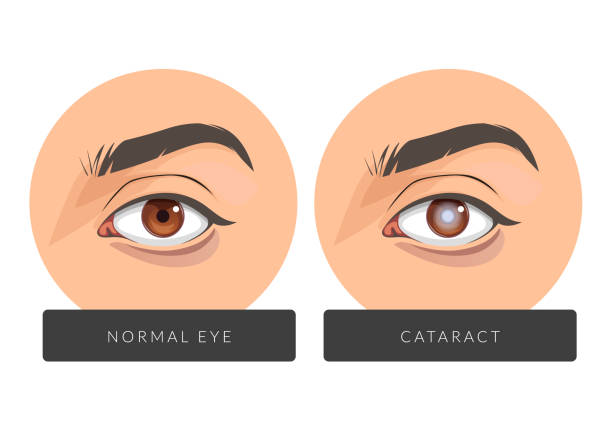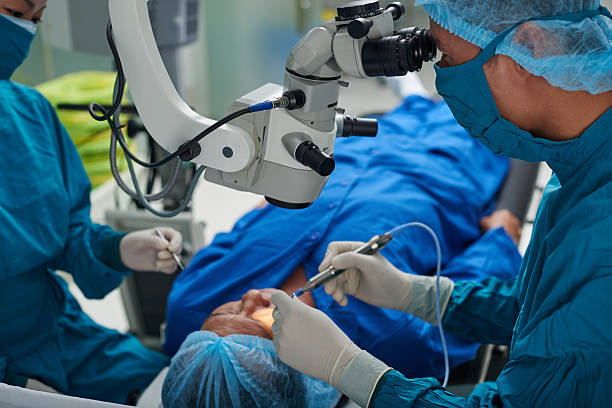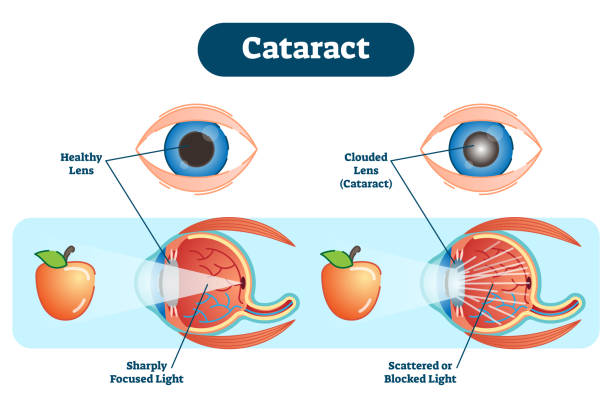Cataracts are a top cause of vision loss around the world. The good news is that medical advances have made cataract treatment safer, quicker, and more effective than ever before. Today’s procedures use cutting-edge tools and offer faster healing times. If you or someone close to you needs cataract surgery, learning about the latest treatment options can help you make a smart and informed choice for your eyesight and overall health.
In this guide, we’ll take you step by step through the latest advances in cataract treatment, including laser-assisted surgery and premium intraocular lenses. These modern options offer better results and faster recovery. Whether you want to learn about new surgical methods or need helpful recovery tips, this article will give you the information you need to feel confident and prepared.
What Are Cataracts?
A cataract is a clouding of the eye’s natural lens, which is normally clear. This cloudiness makes vision blurry or dim and can make it harder to see details. Cataracts usually develop slowly over time and are most often linked to aging. However, they can also form after an eye injury, from certain medications, or as a result of health conditions like diabetes.
Common symptoms of cataracts include:
- Blurry or cloudy vision
- Sensitivity to light and glare
- Trouble seeing at night
- Fading or yellowing of colors
- Double vision in one eye
As the cataract gets worse, it can make daily tasks—like reading, driving, or watching TV—much harder to do. Over time, the blurry vision caused by the cataract can affect your quality of life and make it tough to stay independent.

Why Early Treatment Matters
Cataracts won’t go away by themselves. If they aren’t treated, they can cause major vision problems and may even lead to blindness over time. The good news is that today’s cataract treatments are safe, advanced, and highly effective at restoring clear vision.
Getting early treatment means:
- A faster and smoother recovery
- Better vision outcomes
- Fewer risks and complications
If you’re starting to notice blurry vision, glare, or trouble seeing at night, it’s smart to see an eye doctor as soon as possible. Early visits can help catch cataracts or other eye problems before they get worse.
New Technologies in Cataract Surgery
Let’s take a closer look at the newest technologies that are changing how cataracts are treated. These advances are making surgery safer, faster, and more effective than ever before.
1. Laser-Assisted Cataract Surgery (LACS)
Traditional cataract surgery uses tiny cuts made by hand to remove the cloudy lens. But with laser-assisted surgery, eye doctors use a femtosecond laser to make these cuts with greater accuracy and control. This advanced method can lead to better results and faster healing.
Benefits of LACS include:
- More accurate cuts
- Better lens placement
- Reduced risk of complications
- Shorter surgery time
According to the American Academy of Ophthalmology, laser cataract surgery can offer more consistent and accurate results. It may be especially helpful for people with astigmatism, as the laser can correct the shape of the cornea during the procedure.
2. Premium Intraocular Lenses (IOLs)
Once the cloudy lens is removed, the surgeon places a clear artificial lens called an intraocular lens (IOL). Today, there are many advanced IOL choices available. These go beyond the basic monofocal lens and can help improve both near and far vision, giving patients more freedom from glasses.
Types of premium IOLs:
- Multifocal IOLs – Help you see both near and far without glasses
- Toric IOLs – Correct astigmatism
- Extended Depth of Focus (EDOF) IOLs – Provide a full range of vision
These advanced lenses can lower your need for glasses—and in some cases, you may not need them at all after surgery. Talk to your eye surgeon to see if you qualify for a premium intraocular lens (IOL) that matches your vision needs and lifestyle.
Less Invasive Techniques for Faster Healing
Modern cataract surgery usually takes less than 30 minutes to complete, and most people can go home the same day. Thanks to newer techniques, the recovery process is now even faster and more comfortable. Many patients notice better vision within just a few days.
Smaller Incisions, Less Trauma
Micro-incision cataract surgery uses extremely small cuts, often less than 2mm wide. These tiny incisions help reduce the risk of complications and make it easier for the eye to heal. As a result, patients often experience faster recovery and fewer side effects after surgery.
Suture-Free Surgeries
Thanks to better tools and advanced methods, many cataract surgeries no longer require stitches. This helps the eye heal more quickly and reduces the risk of infection. Patients often feel more comfortable during recovery and get back to normal activities sooner.
Artificial Intelligence and Smart Planning
Today, surgeons use advanced imaging tools and artificial intelligence (AI) to plan cataract surgery with great accuracy. These technologies help create a custom plan for each patient, leading to better results and a smoother recovery.
These tools help by:
- Mapping the eye in 3D
- Measuring the lens and cornea precisely
- Recommending the best IOL for each patient
This means your treatment is personalized to fit your unique eye needs. A custom approach helps improve accuracy and gives you a better chance of clear, lasting results.

New Eye Drops for Early-Stage Cataracts?
Researchers are developing special eye drops that may slow down or even reverse early cataract formation. These drops aren’t widely available yet, but early research shows promising results. In the future, they could offer a non-surgical way to treat cataracts.
One of these new drugs, called lanosterol, is being studied to see if it can break up the protein clumps that cause cataracts. While it’s still in the testing stage, early results look hopeful. If proven effective, these eye drops could change the way cataracts are treated in the future.
You can read more about this research on NIH.gov.
Recovery After Cataract Surgery
Thanks to these new advances in cataract treatment, recovery is often quick and easy. Most patients experience little discomfort and return to normal activities within a few days.
What to expect after surgery:
- Clearer vision within a few days
- Eye drops to prevent infection and swelling
- A follow-up visit with your eye doctor
Most people can get back to their regular activities within a few days after surgery. However, full healing of the eye usually takes about 4 to 6 weeks. During this time, it’s important to follow your doctor’s instructions for the best results.
Tips for a Smooth Recovery
Here are some simple and helpful tips to make your healing process smoother and easier after cataract surgery:
- Avoid rubbing your eyes
- Don’t lift heavy objects for a few weeks
- Wear sunglasses outdoors to protect your eyes from bright light
- Follow all post-surgery instructions from your doctor
- Take prescribed eye drops on schedule
If you notice any pain, redness, or sudden vision changes, call your doctor right away.
Are You a Good Candidate for These New Treatments?
Not every new cataract treatment will be the right fit for every person. Things like your age, overall eye health, daily activities, and budget all matter when choosing the best option.
You may be a good candidate if you:
- Want to reduce your need for glasses
- Have astigmatism or presbyopia
- Prefer the latest in medical technology
- Are looking for a faster recovery
Talking to an experienced eye surgeon can help you find the best option for your needs.
How to Choose the Right Cataract Surgeon
Choosing the right surgeon is key to getting the best results. Look for someone who:
- Is board-certified
- Has experience with the latest techniques
- Uses advanced diagnostic tools
- Offers a range of IOL options
You can search for a qualified eye surgeon using tools like the American Society of Cataract and Refractive Surgery’s directory.

The Cost of Modern Cataract Surgery
Standard cataract surgery is usually covered by insurance or Medicare, making it more affordable for many patients. However, if you choose premium intraocular lenses (IOLs) or laser-assisted surgery, there may be extra costs. Be sure to ask your doctor about pricing and what your plan covers.
Out-of-pocket costs may include:
- Upgrades to premium lenses
- Advanced imaging or AI-guided planning
- Laser-assisted surgery fees
It’s smart to check with your insurance provider before your surgery to see what’s covered. You should also talk to your eye clinic about payment options early on. This can help you avoid surprise costs and plan ahead with confidence.
Final Thoughts: A Bright Future for Your Eyes
Cataract treatment is improving quickly. With new tools, advanced lenses, and smarter technology, patients now have more options than ever. These changes make it easier to find a treatment that fits your vision needs and lifestyle.
Whether you want clearer vision or a quicker recovery, today’s cataract treatments can give you real results and new hope. Don’t wait for your vision to get worse—take the first step toward better eye health today by talking to your doctor.
Have Questions? We’d Love to Hear From You!
Have you or someone you know had cataract surgery recently? Curious about which lens is right for you? Drop your questions in the comments below or contact us for a personalized consultation.
Ready to see clearly again? Talk to your eye doctor today and explore your options. Your brighter future starts now.

